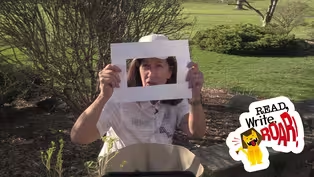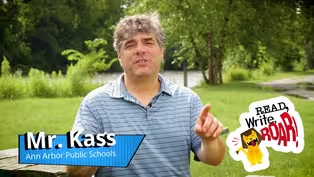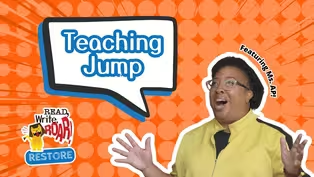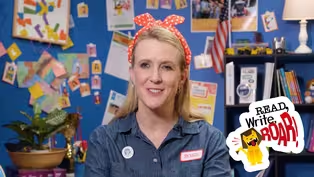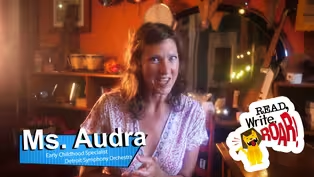Read, Write, ROAR!
Nature Journaling 101: Birdwatching with a Naturalist | Paul Roose | Read, Write, ROAR!
Clip: Season 1 Episode 1001 | 4m 22sVideo has Closed Captions
Join naturalist Paul Roose as he takes you birdwatching and shows you how to start your own nature j
Join naturalist Paul Roose as he takes you birdwatching and shows you how to start your own nature journal! Learn how to observe birds in your backyard and record their size, shape, color, and habitat like a true scientist. No fancy notebook required – just your curiosity and a love for nature!
Problems playing video? | Closed Captioning Feedback
Problems playing video? | Closed Captioning Feedback
Read, Write, ROAR! is a local public television program presented by Detroit PBS
Read, Write, ROAR!
Nature Journaling 101: Birdwatching with a Naturalist | Paul Roose | Read, Write, ROAR!
Clip: Season 1 Episode 1001 | 4m 22sVideo has Closed Captions
Join naturalist Paul Roose as he takes you birdwatching and shows you how to start your own nature journal! Learn how to observe birds in your backyard and record their size, shape, color, and habitat like a true scientist. No fancy notebook required – just your curiosity and a love for nature!
Problems playing video? | Closed Captioning Feedback
How to Watch Read, Write, ROAR!
Read, Write, ROAR! is available to stream on pbs.org and the free PBS App, available on iPhone, Apple TV, Android TV, Android smartphones, Amazon Fire TV, Amazon Fire Tablet, Roku, Samsung Smart TV, and Vizio.
Providing Support for PBS.org
Learn Moreabout PBS online sponsorshipHi, I'm naturalist Paul Roos, and we are heading outdoors to discover Michigan's nature.
And that reading and writing is everywhere.
As a naturalist, I'm reading and writing about things I see in nature all the time.
Today we are birdwatching and recording our observations using a technique called nature journaling.
Nature journaling is done by naturalists and scientists who watch and track changes in the natural world over time by writing, drawing, or photographing things we see in nature.
We not only capture information, but we can also see how this information changes over time.
Birds are everywhere on every continent and you can see birds in the country, in the city, at a playground, in your school, or even in your backyard.
So come birdwatching with me and activate your naturalist skills with some nature journaling.
Some people might think you need a fancy notebook to journal, but you can also just use a piece of scrap paper like me.
So grab something to write with and some paper and let's get started.
First, let's take a look around.
What do you notice?
Notice I'm attracting birds by providing food and water.
Each year I record the first day I see a rabbit.
This year it was March 5th.
It's a lot like Michiganders.
It migrates or moves to Florida in the winter and back here in the spring.
Birdwatchers use five key descriptors to help them identify birds size, shape.
Some color, and habitat.
We can practice nature journaling with their chart using the bird descriptors of the state bird of Michigan.
The rabbit.
Looking at this robins size, is it a small, medium, or large bird?
The robin is a medium sized bird, whereas a black cap chickadee is a small bird and a great blue heron is considered a large bird.
What shapes or features do you see?
Does it have noticeable shapes in its beak or a crest on its head?
The robin has a round head.
Let's listen.
Do you hear a particular sound or rhythm?
What colors do you notice?
This feature really defines the robin because it has a reddish orange breast, blackish brown body, and a yellow bill or beak.
Where's the bird found?
Robin's are found in grassy areas, often in a backyard or a park.
Hunting for worms.
How about a quick review of what we've written in our nature journal?
Now let's practice observing more birds.
Take a moment and journal.
You can write down how many birds you see, or even focus only on one kind of bird over a six day period.
I saw 22 kinds of birds and six robins.
Did you see a black and white bird that had a little pointy tail?
Did you see a small bird that was all brown?
How can we figure out what kind of bird it is or its name?
Naturalists use field guides to identify things in nature.
Field guys are books you can find at your local library or sometimes even online.
Today we had a bird's eye view of nature journaling.
When you journal, not only can you record your observations, but you can also use this space to express yourself creatively through writing, drawing, or photography.
Remember, the sky's the limit when it comes to writing and journaling.
Media Literacy & Camera Shots: Telling Stories Through Film | Ms. Kara | Read, Write, ROAR!
Video has Closed Captions
Clip: S1 Ep1001 | 4m 14s | Learn about different camera shots like establishing shots, medium shots, and close-ups. (4m 14s)
Michigan Farmer: A First-Person Narrative | Jeff Kass | Read, Write, ROAR!
Video has Closed Captions
Clip: S1 Ep1001 | 6m 6s | What’s it like to be a farmer in Michigan? (6m 6s)
Read, Write, ROAR! Restore - Teaching Jump
Video has Closed Captions
Clip: S1 Ep1001 | 1m 54s | Powerful Pencil Jumps: Jump into action with Ms. AP in this 2-minute movement snack. (1m 54s)
Rosie the Riveter - Writing Using Multiple Sources| Mrs. DeFauw | Read, Write, ROAR!
Video has Closed Captions
Clip: S1 Ep1001 | 5m 37s | Watch as Mrs. DeFauw models how to take notes and write summaries to help remember key ideas. (5m 37s)
Symphony Soundscape | Make Music with Ms. Audra | Read, Write, ROAR!
Video has Closed Captions
Clip: S1 Ep1001 | 1m 57s | Become the conductor of your very own symphony! (1m 57s)
Providing Support for PBS.org
Learn Moreabout PBS online sponsorship

- Home and How To

Hit the road in a classic car for a tour through Great Britain with two antiques experts.












Support for PBS provided by:
Read, Write, ROAR! is a local public television program presented by Detroit PBS
